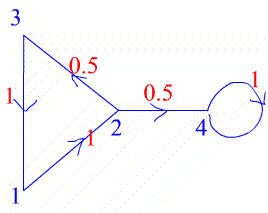Copyright © University of Cambridge. All rights reserved.
'Limiting Probabilities' printed from https://nrich.maths.org/
Show menu

The numbers on the edges of this graph give the probabilities
of a particle travelling along those edges in the direction given
by the arrow. The same information is given by the entry $a_{ij}$
in the following matrix which gives the probability of travelling
from vertex $i$ to vertex $j$. $$A=\left( \begin{array}{cccc} 0
&1 &0 &0 \\ 0 &0 &0.5 &0.5 \\ 1 &0
&0 &0 \\ 0 &0 &0 &1 \end{array} \right)$$
For this question you can use a graphic calculator or computer
software to find powers of the matrices but you need to understand
the definition of matrix multiplication (see the Thesaurus) to be
able to do the question.
Can you see why the square of the matrix gives the
probabilities of travelling from one vertex to another in two
stages and the $n$th power of the matrix gives the probability of
traveling from one vertex to another in $n$ stages? For example $$
A^{20}=\left( \begin{array}{cccc} 0 &0 &0.008 &0.992 \\
0.008 &0 &0 &0.992 \\ 0 &0016 &0 &0.984 \\
0 &0 &0 &1 \end{array} \right) $$ This matrix shows
that there is zero probability of getting from vertex $1$ to vertex
$2$ in $20$ stages (that is along $20$ edges with the paths along
the edges being repeated), but there is a probability of $0.008$
(to 3 significant figures) of travelling from vertex $1$ to vertex
$3$ in $20$ stages.
Work out $A^{21}$ and $A^{22}$ and explain the occurrences of
zero and non zero entries in these matrices.
What would you expect to happen for higher powers, (e.g.
$A^{100}$), and why?